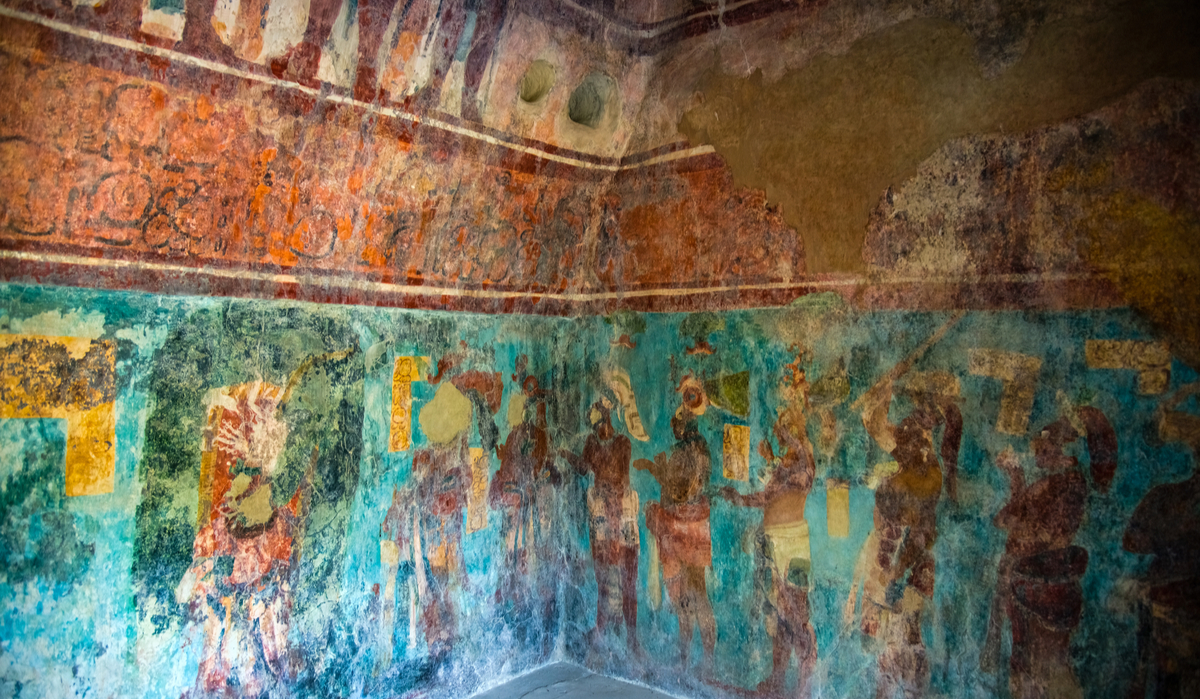Paintings Tell This Maya Story – First Impressions of Bonampak
The Bonampak archaeological zone in Chiapas, Mexico is small, but don’t let its size determine the significance of this Mayan Ruin. The preserved murals in Bonampak, dating back to 790 A.D., are worth the trip to Chiapas. Archeologists believe that Bonampak has the finest examples of classic Mayan frescoes. These murals introduced a different understanding of the Maya culture unseen in other archaeological sites.
Bonampak (pronounced bō-näm-päk’) means “painted wall” in modern Mayan. This name sums up the treasured attraction of this Mayan Ruin; incredibly preserved painted frescoes located in Structure 1 in the Main Plaza.
Professor Mary Miller from Yale Univeristy, who conducted an extensive study of the murals, wrote “Perhaps no single artifact from the ancient New World offers as complex a view of Pre-hispanic society as do the Bonampak paintings. No other work features so many Maya engaged in the life of the court and rendered in such great detail, making the Bonampak murals an unparalleled resource for understanding ancient society.”

Bonampak History Intertwines With the Usumactina River
Bonampak traded and fought with other Maya tribes in surrounding cities, most famously with Yaxchilan and Piedras Negras, which also front on the Usumacinta River. More distant Palenque also used the river for commerce. The Usumactina River bound the various tribes together for trade and, at the same time, pitted them against each other in battles for territory and dominance.
The settlement at Bonampak dates to the Early Classic period (580 to 800 A.D) with its demise thought to be in 900 A.D. with the neighboring settlement of Yaxchilan. The frescoes date to 790 A.D.. If the murals truly reflect the history of Bonampak, it seems that this settlement had more wars and fighting than spiritual genius the Maya are so famous for.
Fast Facts About Bonampak Ruins
- Bonampak is approximately 30 km (19 mi) south of the larger site of Yaxchilan, under which Bonampak was a dependency, and the border with Guatemala.
- Bonampak dates to the Early Classic period (c. AD 580 to 800).
- Collapsed in 900 A.D. with Yaxchilan
- The Mayan murals in Structure 1 show more conflict than mystic genius.
- The paintings date from 790 and were made as frescos, similar method used on pottery.
- Bonampak was first seen by non-Mayans in 1946.
- As of 2012, only the murals and the main plaza are open. Other parts of the site have been closed off and are not accessible to the public even though they haven’t been roped off.

Murals of Bonampak
“Edificio de Las Pinturas” or Structure 1, houses the famed murals in three separate chambers. They were first shown by local Lacandon to international photographer Giles Healey in 1946. The well-preserved murals, believed to have been painted around 790 AD, cover the walls and ceilings of the ‘Building of the Paintings.’ The murals explain in great detail the rituals of the royal court including human sacrifice, costumes, musical instruments, and the weapons of war. The first mural shows the blessing of a child, the second mural a battle including the torture and sacrifice of captives, and the third mural shows a celebration with dances and headdresses.
The paintings were made as frescoes, a technique where paint is applied to wet plaster. The murals reveal no seams in the plaster indicating that each room was painted in a single session as the plaster needs to be wet in order for the paint to adhere. The frescoes used natural colors from plant sources of blue, red, sepia , yellow, mauve, purple and green. Only four people are allowed into each of the rooms at any one time because perspiration (moisture) affects the paintings. When visiting the site, there may be a small wait to enter the mural rooms, but it is worth the wait! You can take photographs of the frescoes, but flash photography is strictly prohibited and enforced by local officials watching visitors.
Making the Trip to Bonampak in Chiapas, Mexico
Chiapas is a southern Mexican State, make a trip to Bonampak part of a larger adventure. In the early 1990s, the Mexican government built a border highway making the trip to Bonampak easier and more accessible. The local public transit is still required for the final trip to the entrance.
If you take on the wonderful adventure to Chiapas, you can go via rental car or ADO public buses. Both options are a pleasure. The trip to Chiapas from the Riviera Maya is approximately 12 hours but can be broken up into a series of stops along the way. Let the adventure begin!
